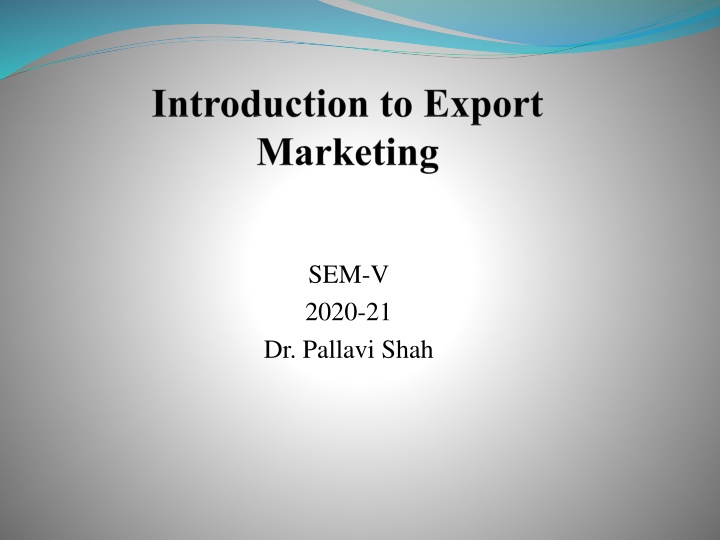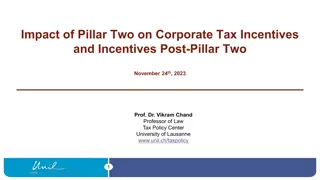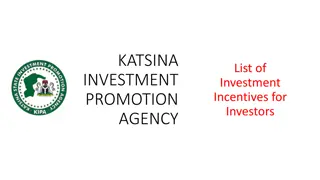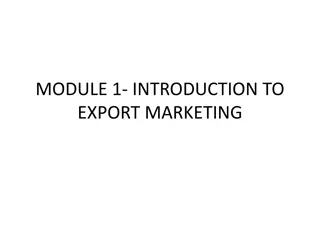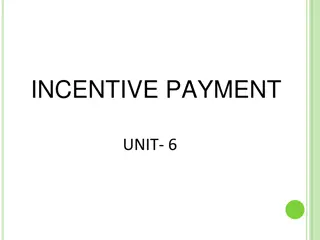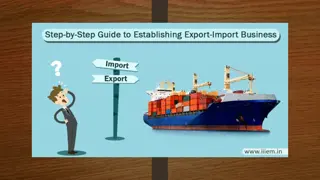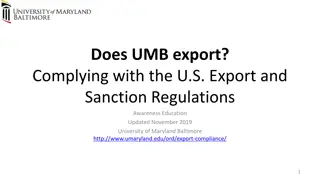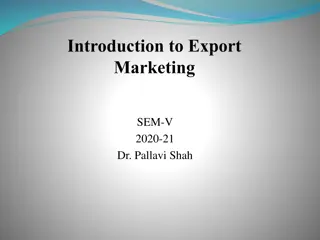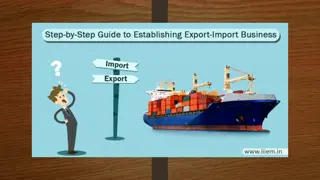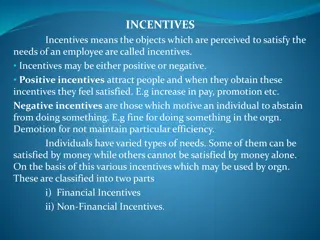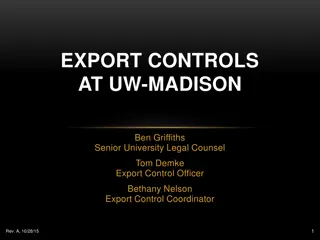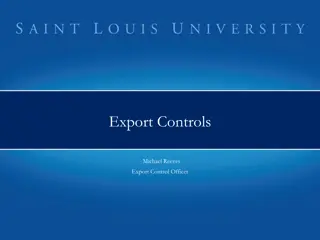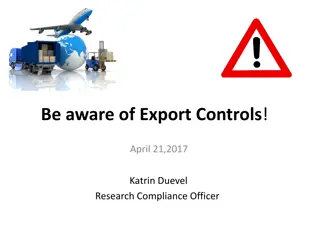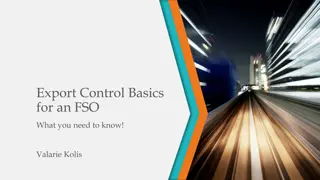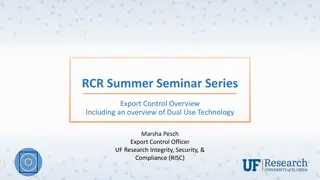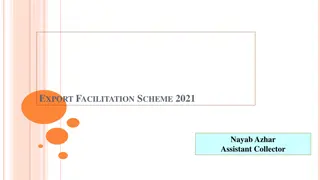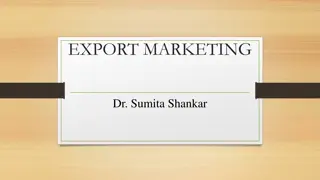Essentials of Export Marketing: Syllabus, Concepts, and Incentives
Explore the syllabus covering Introduction to Export Marketing, Global Framework, India's Foreign Trade Policy, Export Incentives, and more. Learn about the concept and features of export marketing, the importance of exports for a nation, and the various incentives available to Indian exporters. Gain insights into trade barriers, economic groupings, overseas market research, and export promotion schemes.
Download Presentation

Please find below an Image/Link to download the presentation.
The content on the website is provided AS IS for your information and personal use only. It may not be sold, licensed, or shared on other websites without obtaining consent from the author.If you encounter any issues during the download, it is possible that the publisher has removed the file from their server.
You are allowed to download the files provided on this website for personal or commercial use, subject to the condition that they are used lawfully. All files are the property of their respective owners.
The content on the website is provided AS IS for your information and personal use only. It may not be sold, licensed, or shared on other websites without obtaining consent from the author.
E N D
Presentation Transcript
SEM-V 2020-21 Dr. Pallavi Shah
Syllabus 1. Introduction to Export Marketing (a) Concept and Features of Export Marketing, Importance of Exports for a Nation and a Firm, Distinction Between Domestic Marketing and Export Marketing (b) Factors influencing Export Marketing, Risks involved in Export Marketing, Problems of India's Export Sector (c) Major merchandise/commodities Export of India (Since 2015), Services Exports of India (Since 2015), Region-wise India's Export Trade (Since 2015) 2. Global Framework For Export Marketing (a) Trade Barriers, Types of Tariff Barriers and Non-Tariff Barriers, Distinction Between Tariff and Non-Tariff Barriers (b) Major Economic Groupings of the World, Positive and Negative Impact of Regional Economic Groupings, Agreements of World Trade Organisation (WTO) (c) Need For Overseas Market Research, Market Selection Process, Determinants of Foreign Market Selection
Syllabus 3. India's Foreign Trade Policy (a) Foreign Trade Policy (FTP) 2015-20 - Highlights and Implications, Export Trade Facilitations and ease of doing business as per the new FTP (b) Role of Directorate General of Foreign Trade (DGFT), Negative List of Exports, Deemed Exports (c) Benefits to Status Holders and Towns of Excellence, Common Benefits For EHTP, BTP and STP, Benefits enjoyed by (IIAS) Integrated Industrial Areas (SEZ), EOU, AEZ 4. Export Incentives and Assistance (a) Financial Incentives available to Indian Exporters - Marketing Development Assistance (MDA), Market Access Initiative (MAI), Assistance to States for Infrastructure Development for Exports (ASIDE), Industrial Raw Material Assistance Centre (IRMAC) (b) Institutional Assistance to Indian Exporters - Federation of Indian Export Organisations (FIEO), India Trade Promotion Organisation (ITPO), The Federation of Indian Chambers of Commerce and Industry (FICCI), Export Promotion Councils (EPCs) and Commodity Boards (CBs), Indian Institute of Foreign Trade (IIFT), Indian Institute of Packaging (IIP) (c) Schemes - Export Promotion Capital Goods (EPCG) Scheme, Duty Exemption and Remission Schemes, Export Advance Authorisation Scheme, Duty Drawback (DBK), IGST Refund for Exporters
Concept and Features of Export marketing Export marketing involves export business with individuals, firms, organisations and or government entities in other countries . Features 1. Systematic process 2. Customer Focus 3. Customs formalities 4. Customs and Traditions 5. Documentation 6. Dominance of MNCs 7. Trade barriers 8. Trading blocs 9. Three-faced competitions 10, Large scale operation 11. Subject to regulations 12. Marketing mix 13.International marketing research 14. Spreading of risk 15. Reputation
Importance of export for a nation Foreign exchange International relations Balance of payments Reputation in the world Employment Research and development Regional development Optimum use of resources Standard of living Economic growth Spread effect
Importance of export for a firm Reputation Optimum production Spreading of risks Export obligation Research and development Organisational efficiency Liberal imports Economics' of scale Keeping alive old products Higher prices
Domestic marketing Vs Export marketing Meaning Mobility Monetary system Taxes and levies Transport costs Trading blocs Culture/ language Currencies Competition Exchange of goods Scale of operation Risks Procedures
Factors influencing export marketing I- Firm specific factors Rate Of Profit Recovery Of R and D Expenses Strategic Vision Sales And Production Stability Extension Of Product Life Cycle Advantage Of Monopolistic Position
Factors influencing export marketing II External environment factors Competition in domestic market Domestic market constraints i. Saturation of domestic market iii. Economics of Scale iii. Domestic recession Economic growth Free Trade agreement Government incentives Information and Media revolution World Trade Organistion
Risk involved in export marketing Quality related risk Foreign exchange fluctuations risks Credit risk Cargo risk Legal risk Unforeseen risk Language and culture risk Political risk Commercial risk Intellectual property risk
Problem of Indias Export sector Recession in the world market Protectionist measures by developed countries Reduction in export incentives Competition from china Problem of product standards Problem of anti-dumping duties Problem of sea pirates attacks Negative attitude of overseas buyers Documentation formalities Foreign exchange regulations Poor Infrastructure Problem of Trading Blocs Exporters related Problems
Direction of Indias export since 2015 Export of OECD Countries OPEC countries Eastern Europe Developing countries Export to other nations
Composition of Indias merchandise Manufactured items Agriculture items Crude and petroleum products Ores and minerals
Indias services export Software services Business services Travel Transportation Financial services other
Module II Global framework for exports Trade barriers Major economics grouping World trade organisation Overseas market selection
Trade barriers Trade Barriers Traffic barriers Non-tariff barriers
Tariff Barriers Specific duty Ad valorem duty Seasonal duty Anti-dumping duty Countervailing duty Revenue tariff Anti dumping duty Protective tariff
Non- Tariff barriers Quota system Products standards Domestic content requirements Product labeling Packaging requirements Consular formalities State trading Preferential arrangements Foreign exchange regulations
Negative implication Effect on world trade Effect on consumer welfare Corruption and red tape Breeds inefficiency Restricts competition Effect on economic growth
Regional economic grouping Types of economic integration 1. Preferential trade arrangement 2. Free trade area 3. Customs unions 4. common market 5. Economic Union
Impact of regional economic grouping POSITIVE IMPLICATIONS Trade Creation Competition Economies Of Large Scale Economic Growth Employment Technological Development Investment Social And Cultural Relations Better Utilization of Resources Consumer Welfare
NEGATIVE IMPLICATIONS Common External Barriers Collective Bargaining By member Nations Lack Of Interest In Multilateralism Trade Diversion
Objectives Of EU The promotion of peace and the well-being of the Union s citizens An area of freedom, security and justice without internal frontiers Sustainable development based on balanced economic growth and social justice A social market economy - highly competitive and aiming at full employment and social progress A free single market Employment opportunities Social cultural relations To remove trade barriers
Benefits of to member nations General Advantages Membership in a community of stability, democracy, security and prosperity; Stimulus to GDP growth, more jobs, higher wages and pensions; Growing internal market and domestic demand; Free movement of labour, goods, services and capital; Free access to 450 million consumers. Macroeconomic Impacts Growing inflow of FDI due to increased business confidence; Reduced risks, more mobile workforce; A regional hub and gateway: access to East Europe and the Balkans; Efficient transport through the major Helsinki corridors; Stronger competition and a drive for innovation; State subsidy system harmonised with EU regulations; Easier access to financial institutions and funds within the enlarged European Union; One percent point additional increase in GDP and industrial output growth due to higher export sales dynamics. Benefits for companies Increased access to EU funds and support for SMEs; Transparency of taxation and business accounting rules; No customs or quantitative restrictions within the EU; Simplified administrative procedure when trading with other EU member states; Easy access to a market of 450 million consumers for non-European companies settled in Hungary. Reduction of non-tariff trade barriers Mutual certification of goods; Single standard certification process for the entire region; Rigorous enforcement of competition policy and intellectual property rights; Harmonized VAT payment system in the EU.
Association of south east asian nations OBJECTIVES OF AFTA To remove tariffs on goods produced in the ASEAN Countries To encourage FDI in the region To assist member nations during emergencies To improve social and cultural regions amongst member nations To promote regional peace and stability
South Asian Association For Regional Corporation OBJECTIVES OF SAARC Promoting the welfare of the people of South Asia and to improve their quality of life. Accelerating economic growth, social progress and cultural development in the region and to provide all individuals the opportunity to live in dignity and to realize their full potential. Promote and strengthen collective self-reliance among the countries of South Asia. Contribute to mutual trust, understanding and appreciation of one another's problems. SAPTA SAFTA
North American free Trade Area OBJECTIVES OF NAFTA To eliminate trade barriers & facilitate the cross-border movements. To promote conditions of fair competition. To substantially increase investment opportunities. To provide adequate and effective protection & enforcement of intellectual property rights To create effective procedures for the implementation and application of this agreement. To establish a framework for further trilateral, regional and multilateral co-operation.
Measures undertaken by NAFTA Residents of NAFTA nations can invest freely in other NAFTA countries Protection of intellectual property rights of the member countries Free movement of labour from one country to one another Pollution control along the USA-Mexico border Standardization of product standards in member countries
Special Achievements Of NAFTA members Increase in trade among member nations Increase in FDI Agricultural Exports Employment Mexico Overcomes Financial Crisis Improved Political Relations Consumer Welfare Increase in GDP Of Member Nations
World Trade Organisation OBJECTIVES OF WTO Trade without discrimination Settlement Of Disputes Raising Standard Of Living Optimum Use of World s Resources Protection Of Environment Growth of less developed countries Employment Enlargement of Production and trade
Role of WTO The main goal of WTO is to help the trading industry to become smooth, fair, free and predictable. It was organized to become the administrator of multilateral trade and business agreements between its member nations. It supports all occurring negotiations for latest agreements for trade. WTO also tries to resolve trade disputes between member nations. Multi-lateral agreements are always made between several countries in the past. Because of this, such agreements become very difficult to negotiate but are so powerful and influential once all the parties agree and sign the multi-lateral agreement. WTO acts as the administrator. If there are unfair trade practices or dumping and there is complain filed, the staff of WTO are expected to investigate and check if there are violations based on the multi- lateral agreements. The system helps promote peace. The system allows disputes to be handled constructively. A system based on rules rather than power makes life easier for all. Free trade cuts the cost of living. It gives consumers more choice and a broader range of qualities to choose from. Trade raises incomes. Trade stimulates economic growth and that can be good news for employment The basic principles make the system economically more efficient, and they cut costs.
Objectives WTO 4. OBJECTIVES OF WTO To arrange the implementation, administration and operations of multilateral (involving three or more participants) and Plurilateral trade agreements (power which shared between different countries) To arrange the forum for deliberations for the member nations in regard to their multilateral trade relations in issues deal with under the agreements. To provide a framework for implementing of the results arising out of the deliberations (long and care full agreements/consideration) which taken place at ministerial conference level To manage the created understanding on rules and procedure governing the settlement of disputes To manage effectively and efficiency the trade policy review mechanism (TRIM) To create more together relationship with all nations in respect of global economic policy- making, it would cooperate with the IMF and the world bank & its affiliated Organizations. Administering WTO trade agreements Forum for trade negotiations Handling trade disputes Monitoring national trade policies Technical assistance and training for developing countries Cooperation with other international organizations
Functions of WTO Reduction in Trade barriers Assistance to developing nations Forum for negotiations Administration of WTO agreements Collection of information Consultancy services Examination of member nations policies Settlement of disputes
WTO Agreements TRIPS (TRADE-RELATED ASPECTS OF INTELLECTUAL PROPERTY RIGHTS AGREEMENT) The TRIPs Agreement came into effect on 1 January 1995. It provides standards for the full range of intellectual property rights and also the enforcement of those standards both internally and through legal and administrative actions. The general timetable for implementing the TRIPs agreement is 1 year for industrialised countries; 5 years for developing countries and countries shifting from centrally planned economics; 10 years for least developed countries.
Implications Of TRIPS Agreement POSITIVE IMPLICATIONS TRIPs and Patents TRIPs and Public Health TRIPs and Geographic Indication Status (GIS) NEGATIVE IMPLICATIONS TRIPs and Developed Nations TRIPs and Agriculture TRIPs and Micro-organisms
The Agreement on Trade-Related Investment Measures (TRIMS) recognizes that certain investment measures can restrict and distort trade. It states that WTO members may not apply any measure that discriminates against foreign products or that leads to quantitative restrictions, both of which violate basic WTO principles. A list of prohibited TRIMS, such as local content requirements, is part of the Agreement. The TRIMS Committee monitors the operation and implementation of the Agreement and allows members the opportunity to consult on any relevant matters.
Implication Of TRIMS Agreement POSITIVE IMPLICATIONS Foreign Direct Investment Consumer Welfare Competition Benefits NEGATIVE IMPLICATIONS Interference in Domestic Affairs Effect on Small Firms Outdated Technology
Gats Agreement The General Agreement on Trade in Services (GATS) is a treaty of the World Trade Organization (WTO) which entered into force in January 1995 as a result of the uruguay Round negotiations. The treaty was created to extend the multilateral trading system to service sector, in the same way the General Agreement on Tariffs and Trade (GATT) provides such a system for merchandise trade. All members of the WTO are parties to the GATS. The basic WTO principle of most favored nation (MFN) applies to GATS as well. However, upon accession, members may introduce temporary exemptions to this rule.
Implication Of GATS POSITIVE IMPLICATIONS Exports Of Services Expansion Of Service Sector Customer Service NEGATIVE IMPLICATIONS Problem Of Competition Outflow Of Foreign Exchange
Agreement on Agriculture The Agreement on Agriculture (AoA) is an international treatyof the World Trade Organization. It was negotiated during the Uruguay Round of the General Agreement on Tariffs and Trade, and entered into force with the establishment of the WTO on January 1, 1995.
Implications POSITIVE IMPLICATIONS Reduction In Tariff Duties Increase In market Access Reduction In Export Subsidies Reduction in domestic Support NGATIVE IMPLICATIONS Reduction in Tariff duties Increase In market Access Reduction In Export Subsidies Reduction in domestic Support
Marketing Research As per American marketing association the systematic gathering recording and analysis of data about problem relating to the marketing of goods and services. NEEDS AND IMPORTANCE: 1. Consumer needs and wants 2. Competitive advantage 3. Effectiveness of Channel Of distribution 4. Effectiveness Of promotional measures 5. Packaging Design 6. Forecasting Cells 7. Pricing Decision
Determinants of Foreign Market selection Competition Customer Import Regulation Size Of Market Distribution Network Availability Of After Sale Service Preferential Treatment Economic Stability Political Stability Business Community Location
Market Selection Process STEPS IN MARKET SELECTION PROCESS Determining Export Marketing Objectives 2. Collection Of Information 3. Analysis Of Information 4. Shortlisting Of Market 5. Detailed Investigation 6. Selection of Market 7. Entry In Overseas Market 8. Follow-Up 1.
